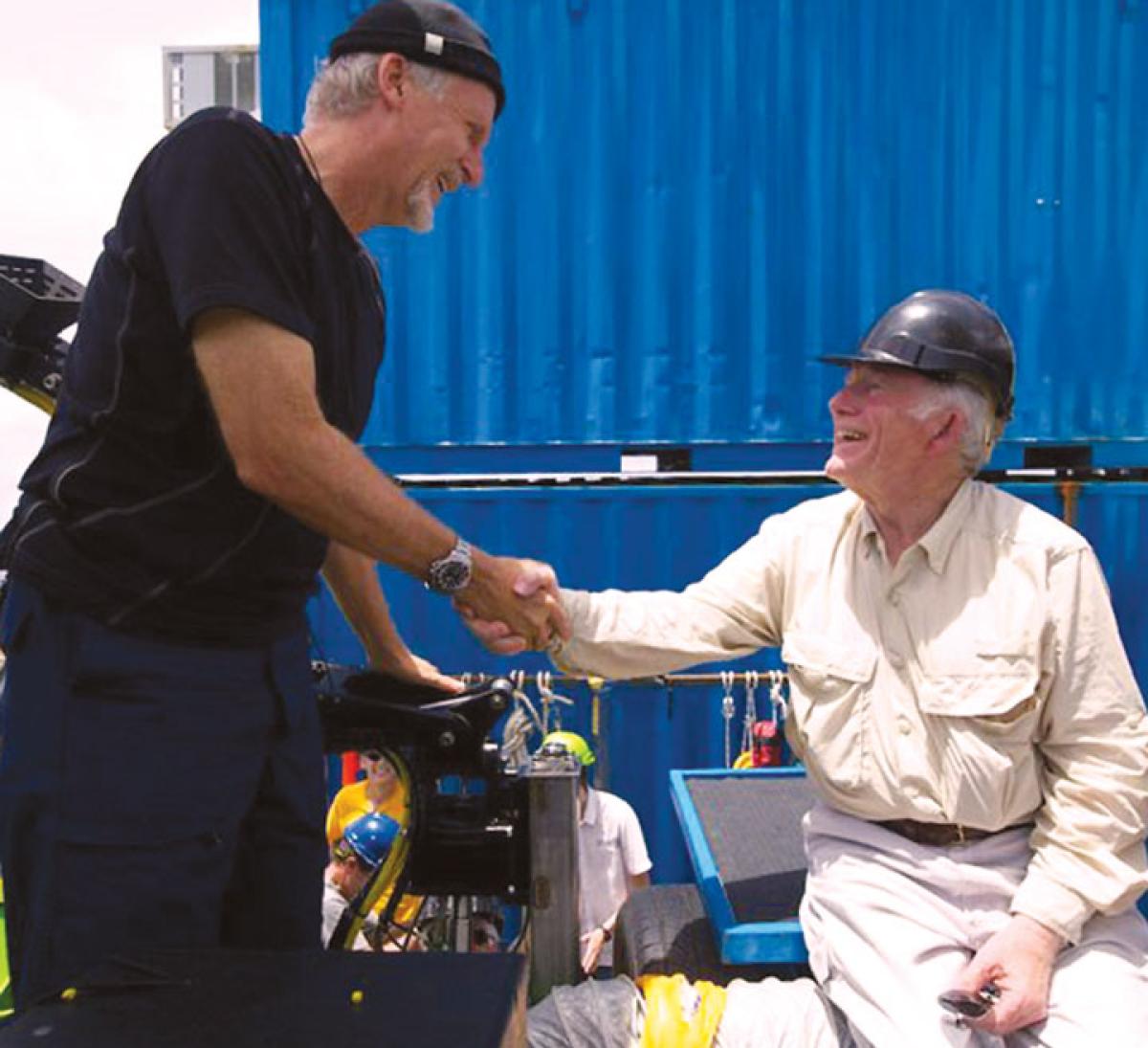In the early morning hours of 26 March, explorer/Oscar-winning filmmaker James Cameron realized a decade-old dream. He piloted his manned submersible, the Deepsea Challenger, to the deepest place in the World Ocean, the Challenger Deep in the western Pacific’s Mariana Trench. Cameron’s maximum depth was 35,756 feet, only 84 feet less than the Navy’s bathyscaph Trieste 52 years earlier.
This story began for me in December 2003 when I was invited to visit Jim’s offices in Malibu, California. We spent a fascinating day discussing his plan to build a full-ocean-depth manned submersible. Then for the next seven years, I heard nothing more about his project.
That changed last January when I was asked to go to Sydney, Australia, to spend a week at the shop facility where the submersible was being constructed. I expected to see a warehouse floor covered with component pieces but no submersible. What I found was quite different. A team of 35 technicians had virtually completed the Deepsea Challenger!
The Deepsea Challenge Expedition project had two major sponsors in addition to Cameron’s own resources: the National Geographic Society and Rolex. Project costs have not been revealed, but they appear to be on the north side of $20 million. There was not a penny of government funding in any of this work.
The sub represents a remarkable departure from conventional manned submersibles. All such vehicles have two primary components—a thick-walled spherical pressure hull for the people and an egg-shaped external framework filled with special foam to provide buoyancy. The 12-ton Deepsea Challenger has those basic elements, but the resemblance with conventional deep submersibles ends there. In order to be able to dive rapidly, this craft resembles a vertical torpedo or spar buoy.
After shallow test dives near Sydney, the sub left for Papua, New Guinea, on board its dedicated mother ship, the 206-foot Mermaid Sapphire. Maximum depth reached by Cameron in this deep-test series was 27,000 feet. He was now one of only 12 deep-ocean explorers who had reached that depth.
Next, the Sapphire headed north toward Guam and the nearby Challenger Deep. It was now mid-March, and everything was ready for sailing to the dive site 184 miles southwest of Guam. I rejoined the expedition at this time. We now were accompanied as well by a dozen oceanographers on the board the 130-foot support ship Barakuda.
On 24 March, the Deepsea Challenger made an unmanned maximum-depth dive. Acoustically transmitted telemetry data showed the sub descending at about 2.5 knots, nearing the bottom, and then hovering just above the seafloor at a depth of 35,350 feet. While some minor repairs and adjustments were required, the Deepsea Challenger performed exactly as designed.
On 26 March the Sapphire launched the Deepsea Challenger with the 6-foot-2-inch Cameron crammed into the small cabin. Just before the hatch was closed I told him, “Good luck and have fun!” During the two-and-a-half-hour descent Jim was able to have both voice and Twitter communications with the Sapphire’s control room via acoustic links. The telemetry gave the sub’s continuous depth and position data. At 0900 he arrived at the bottom of the Challenger Deep and spent two and a half hours there.
It took the Deepsea Challenger only 70 minutes to reach the surface. It was midday now, and as he opened the hatch, I greeted a smiling Jim: “Congratulations and welcome to a very exclusive club! You and I are the only living persons who have been this deep in the oceans.”
It was a great honor to have been part of this historic expedition. In 1960, after Jacques Piccard and I surfaced from our dive, we sat topside waiting for the boat. We talked about when the next manned expedition would return to the Challenger Deep. As I recall, we agreed that it might be at least two years away. In fact, it was 52 years later.
The Deepsea Challenge Expedition was not a one-off record-setting project. The next phase of diving operations will return to the Challenger Deep where imagery, scientific data, and physical sampling will be accomplished. Operations will resume not only at the Challenger Deep but also within other deep ocean-trench systems.
Borrowing a line from his movie The Terminator, James Cameron says, “I’ll be back!”



